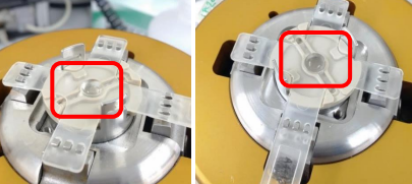Video: Sample Changeover
Sample changeover is the critical and most common place where blockages can occur, predominantly through introduced bubbles. It is important to clean the upper fluid well properly between samples as otherwise there may be contamination from the previous sample, which can affect the size and concentration.
Changeovers must also be done efficiently to avoid pore drying between recordings. It is very important that the top surface of the nanopore doesn't run dry, to maintain complete pore wetting.
Follow these steps during sample changeovers:
- Remove the applied pressure: Pull the gauge to “0”, open the vent valve and disconnect the VPM nozzle.
- Note the baseline current (nA) value.
- Remove the upper fluid cell. A droplet of fluid should remain on top of the nanopore. TIP: Immediately pipette 35 µL of Measurement Electrolyte to the centre of the nanopore surface to maintain pore hydration, as shown below.

- Wash the upper fluid well with deionised water, then dry it with compressed gas.
- Vortex the next sample in short bursts to mix.
- Dry the top of the nanopore with a lint-free tissue (Kimwipe).
- Immediately fit the upper fluid cell and pipette 35 µL of the next sample into the upper fluid well.
- Click the fluid cell cap into place. Ensure the baseline current returns to the value used in previous recording (Step 2) within 5% and stability is maintained.